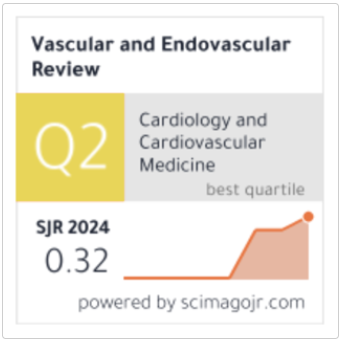A comparison between Percutaneous Bleomycin and Polidocanol in management of peripheral venous malformations
DOI:
https://doi.org/10.64149/J.Ver.8.2.58-71Keywords:
Percutaneous Bleomycin, Polidocanol, Peripheral Venous Malformations.Abstract
Background: Venous malformations (VMs) are congenital slow-flow vascular anomalies that can cause pain, swelling, functional impairment, and cosmetic concerns. Sclerotherapy has become a primary, minimally invasive treatment option, with Bleomycin (an antineoplastic antibiotic) and Polidocanol (a detergent sclerosant) being commonly used agents. Both have demonstrated efficacy in reducing lesion size and symptoms, yet direct comparisons of their safety profiles, complication rates, and patient outcomes remain limited.
Objective: To compare between Bleomycin and polidocanol injection in the treatment of peripheral venous malformations as regard the reduction in size/session, number of sessions used, postprocedural pain, cost and complications.
Patients and Methods: This randomized clinical trial was conducted on 24 patients with peripheral low flow vascular malformation who randomly classified into 2 groups: group A: 12 patients subjected to Polidocanol injection, group B; 12 patients subjected to Bleomycin percutaneous injection, at ‘Interventional radiology unit’ at the Radiology Department “Ain Shams University hospitals, Cairo, Egypt, to compare between Bleomycin and polidocanol injection in the treatment of peripheral venous malformations as regard the reduction in size/session, number of sessions used, postprocedural pain and complications.
Results: In this study of 24 patients (58.3% male, median age 10 years) with venous malformations, the upper limb was most affected (46.2%). Pain (70.8%) and swelling/disfigurement (91.7%) were common. Sclerotherapy with Bleomycin or Polidocanol (50% each) resulted in reduced lesion sizes (median 9 cm³ to 4 cm³ at 1 month, further declining by 6 months) and pain scores (median 8 to 0). By 6 months, 54.2% achieved complete response, 41.7% partial, and 4.2% stable. Complications (62.5%) included pain (50%) and swelling (45.8%). Polidocanol showed higher local complications (83.3% vs. 41.7%, p=0.035) but no significant differences in efficacy between agents.
Conclusion: In this randomized clinical trial, both Bleomycin and Polidocanol demonstrated comparable efficacy in reducing lesion size and alleviating pain over a six-month period. By one month, all patients in both groups exhibited partial responses. At six months, the Polidocanol group had a higher rate of complete response (66.7% vs. 41.7%), although this difference was not statistically significant (P = 0.351). While Polidocanol showed a trend toward more complete responses, it was associated with a significantly higher incidence of complications (83.3% vs. 41.7%, P = 0.035), particularly pain (75% vs. 25%, P = 0.014) and swelling (66.7% vs. 25%, P = 0.041). In contrast, Bleomycin had fewer overall complications, but still yielded effective clinical outcomes.








